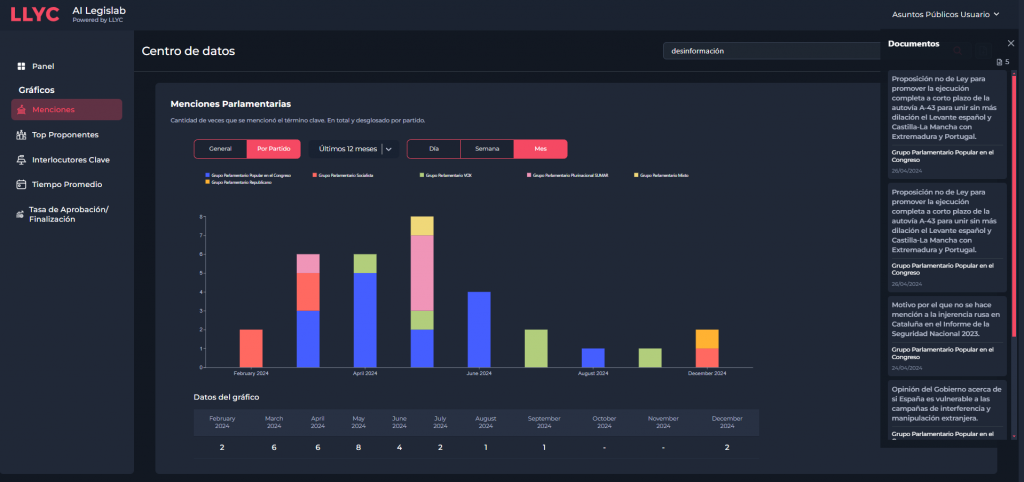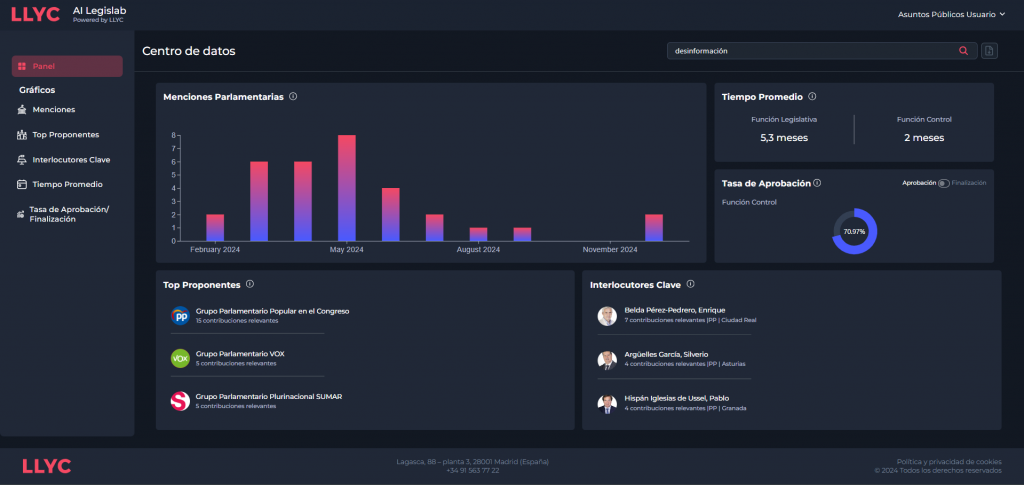
-
TrendsArtificial Intelligence
-
SectorPublic Administration
-
CountriesGlobal
Imagine an infinite ocean of legislative documents: bills, motions, parliamentary questions or amendments. Every day, this ocean grows with new publications from national, regional and European institutions. It seems difficult to bring order to this, but today we are already capable of organising and classifying all this information. But… if we could extract patterns and conclusions from all the data accumulated in Spain over recent decades, we would see legislative information in 3 dimensions and we could learn from it.
Well, that is precisely what we at LLYC have developed: AI Legislab, a tool that not only organises the information in that ocean, but also extracts the most relevant treasures, classifies them, interprets them and presents them in an understandable and accessible way.
Our platform, based on artificial intelligence (AI) and designed with advanced technological architecture, will transform the way parliamentary activity in Spain is analysed.
AI Legislab allows our team of Public Affairs experts to find all the necessary information to design advocacy and lobbying plans on a specific issue with a greater degree of reliability and efficiency: from the average processing time, the most active parliamentary groups and MPs, the historical rate of approval and completion of similar initiatives and many other features.
Until now, we designed strategies and action plans based on intuition and experience.
These are fundamental skills for success, but now technology allows us to go further: by incorporating intelligent and massive data processing, a third dimension opens up for Corporate Affairs. With AI Legislab, we can help our clients anticipate risks, seize regulatory opportunities and increase their strategic agility, especially for highly regulated sectors. By using this advanced technology, we transform complex legislative information into clear and actionable knowledge, enabling informed decision-making and strengthening the competitive position of companies. And all in a way that was not possible before.
But how does it work?
AI at the service of legislative analysis
The machinery starts with AI algorithms. These algorithms have been trained to ‘understand’ legislative language and publication patterns on the websites of parliamentary institutions. But their intelligence goes further: they not only track existing information, but also continuously learn to identify new sources, explore public repositories and discover relevant documents as they appear.
This intelligent approach is what sets our tool apart. Crawlers don’t just follow links or mechanically download content; instead, they perform contextual analysis to understand which documents contain key information and how they relate to each other. In essence, AI allows us to convert mountains of chaotic data into a structured knowledge base.
Three technological pillars that support the platform
Our tool is built on a solid and efficient architecture, made up of three large blocks: crawlers, indexers and an interactive web front end. Each one plays a crucial role in ensuring that the system is fast, accurate and easy to use.
- The trackers: intelligent explorers of the legislative environment. The trackers are digital detectives that explore the web, identifying and downloading key documents related to parliamentary activity. Thanks to AI, these trackers not only search for keywords, but also understand the context: they identify the names of parliamentarians, detect relevant political initiatives and categorise projects according to their subject (such as housing, health or food legislation).
- Indexers: knowledge organisers. Once the documents reach the system, the indexers spring into action. They are responsible for processing the downloaded information, cleaning it up and structuring it so that it is easy to search and analyse. This is where AI shows its true power, as indexers automatically classify information, recognise patterns and relationships, and extract key concepts. The result is an optimised database that allows for fast and accurate searches.
- The web front end: information at your fingertips. An application designed with the user in mind. This interface not only allows you to search for information in less than three seconds, but also includes advanced visualisation tools. Users can view graphs, tables and summaries that help them easily identify key insights and trends. For example, a user can analyse how healthcare initiatives have evolved over the last five years or compare the proposals of different political groups in a specific area. All this is presented in a clear and visual way, so that anyone, even without technical knowledge, can access the information.


An expanding platform
To provide information for the platform, following the original design provided by the team of engineers and consultants at LLYC, the algorithm has processed 230,000 initiatives and more than 100 GB corresponding to the Congress and soon 180,000 initiatives and another 70 GB from the Senate will be added.
The exciting thing is that this is just the beginning. Our roadmap includes the incorporation of all legislatures of the Lower House (Congress of Deputies) and the Upper House (Senate) in Spain, which will allow us to analyse long-term trends. And we will progressively incorporate data from the autonomous parliaments and the European institutions, expanding the scope and depth of the searches. Similarly, many other features that expand the depth of analysis are in different stages of development.
In short, with each step, we continue to use AI to make the system more intelligent and efficient. This includes improvements in semantic interpretation capabilities, which will enable even more natural and intuitive searches.
With this solution, we reaffirm our commitment to innovation through technology, as well as excellence in strategic advice, giving public affairs and corporate affairs professionals a key competitive advantage in an increasingly complex and dynamic environment.
For more information:




